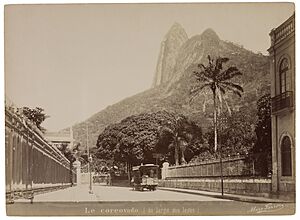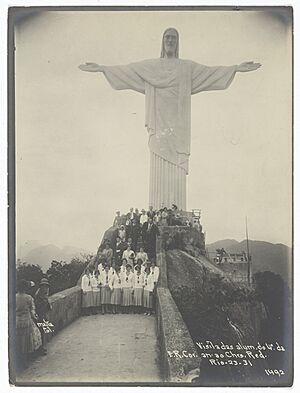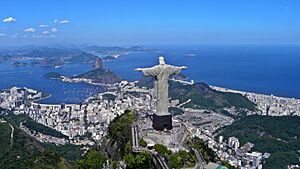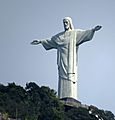Christ the Redeemer (statue) facts for kids
| Cristo Redentor | |
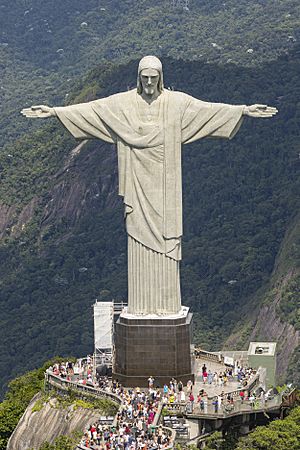
The statue in 2022
|
|
| Coordinates | 22°57′7″S 43°12′38″W / 22.95194°S 43.21056°W |
|---|---|
| Location | Corcovado mountain, Rio de Janeiro, Brazil |
| Designer | Designed by sculptors Paul Landowski and Heitor da Silva Costa and built by engineer Heitor da Silva Costa in collaboration with Albert Caquot. Sculptor Gheorghe Leonida created the face |
| Material | Reinforced concrete with soapstone veneer |
| Width | 28 metres (92 ft) |
| Height | 30 metres (98 ft), 38 metres (125 ft) with its pedestal |
| Completion date | Dedicated October 13, 1931 |
| Consecrated October 12, 2006 New Seven Wonders of the World July 7, 2007 |
|
|
National Historic Heritage of Brazil
|
|
| Designated: | 2001 |
| Reference #: | 1478 |
The Christ the Redeemer statue is a famous Art Deco sculpture of Jesus in Rio de Janeiro, Brazil. It was designed by French-Polish sculptor Paul Landowski and built by Brazilian engineer Heitor da Silva Costa. French engineer Albert Caquot also helped, and Romanian sculptor Gheorghe Leonida created the face.
This huge statue was built between 1922 and 1931. It stands 30 metres (98 ft) tall, not counting its 8-metre (26 ft) base. Its arms stretch 28 metres (92 ft) wide. The statue is made from reinforced concrete and a special kind of stone called soapstone.
Did you know the statue almost looked different? The first idea was for Jesus to hold a globe and a cross. But they changed the plan to the statue we see today, with its arms spread wide open. This pose has become a symbol of peace.
The statue weighs about 635 metric tons. It sits on top of the 700-metre (2,300 ft) Corcovado mountain. This mountain is inside the Tijuca National Park and looks out over the city of Rio de Janeiro. Christ the Redeemer is the largest Art Deco-style sculpture in the world. It is a symbol of Christianity and a major cultural icon for both Rio and Brazil. People even voted it one of the New 7 Wonders of the World.
Contents
Building the Famous Statue
The idea for a Christian monument on Corcovado mountain first came up in the mid-1850s. A priest named Pedro Maria Boss suggested it to honor Princess Isabel of Brazil. However, this plan was not approved. Later, in 1889, Brazil became a republic, and the idea was put aside because the government and church were separated.
In 1920, a group called the Catholic Circle of Rio suggested building a statue again. They wanted to inspire faith in society. They held an event to collect money and signatures. Most of the donations came from Brazilian Catholics.
Many designs were thought of for the "Statue of the Christ." Some ideas included a Christian cross or Jesus holding a globe. But in the end, the statue of Christ the Redeemer with open arms was chosen. This design became a symbol of peace.
Local engineer Heitor da Silva Costa and artist Carlos Oswald created the design. French sculptor Paul Landowski then made the actual statue.
In 1922, Landowski asked Romanian sculptor Gheorghe Leonida to sculpt the face. Engineers decided to build the statue using reinforced concrete instead of steel. This was a good choice for its cross-like shape. The outer part of the statue is covered in soapstone. This stone was chosen because it lasts a long time and is easy to work with.
Building the statue took nine years, from 1922 to 1931. It cost a lot of money, about $250,000 in 1921. The monument officially opened on October 12, 1931. For the opening, they planned to turn on the lights remotely from Rome, Italy. But because of bad weather, the lights had to be turned on right there at the statue.
In October 2006, a small chapel was opened under the statue. It was named after Brazil's patron saint, Our Lady of the Apparition. This chapel allows people to hold baptisms and weddings there.
Keeping the Statue Safe
The statue has been hit by lightning several times. On February 10, 2008, a lightning strike damaged its fingers, head, and eyebrows. The government worked to fix it and replace some of the soapstone. They also repaired the lightning rods on the statue.
On January 17, 2014, lightning struck again, damaging a finger on the right hand. In 2010, a big restoration project started. Workers cleaned the statue, replaced mortar and soapstone, and fixed the inside structure. They also made the monument waterproof.
Sadly, during this work, some vandals sprayed paint on the statue's arm. The mayor called it "a crime against the nation." The people responsible later said sorry and turned themselves in to the police.
Fixing and Caring for the Statue
Several groups worked together to restore the statue in 1990. These included the Archdiocese of Rio de Janeiro and other important organizations.
More work was done in 2003 and 2010. In 2003, escalators, walkways, and elevators were added. This made it much easier for visitors to reach the platform around the statue.
The four-month restoration in 2010 focused on the statue itself. Workers cleaned off fungi and tiny living things from the soapstone. They also fixed small cracks. The lightning rods on the statue's head and arms were repaired, and new lights were put at its base.
This restoration involved 100 people. They used over 60,000 pieces of stone from the same place as the original statue. When the restored statue was shown, it was lit up in green and yellow. These are the colors of the Flag of Brazil, to support the Brazil national football team during the 2010 FIFA World Cup.
The statue needs regular care because of strong winds, erosion, and lightning strikes. The original pale stone is hard to find now. So, replacement stones are sometimes a bit darker.
Other Similar Statues
Many other statues around the world are similar to Christ the Redeemer. Here are a few:
- Cristo Rei in Lubango, Angola (14 m, 46 ft)
- Cristo de la Concordia in Cochabamba, Bolivia (34 m, 112 ft)
- Christ the Protector in Encantado, Rio Grande do Sul, Brazil (43 m, 141 ft)
- Cristo Rey in Cali, Colombia (26 m, 85 ft)
- Christ of Havana in Havana, Cuba (20 m, 66 ft)
- Cristo Rei of Dili in Dili, East Timor (27 m, 89 ft)
- Christ Blessing in Manado, Indonesia (30 m, 98 ft)
- Cristo Redentore in Maratea, Italy (21 m, 69 ft)
- Cristo Rey in Guanajuato, Mexico (23 m, 75 ft)
- Christ the King in Świebodzin, Poland (33 m, 108 ft)
- Cristo Rei in Almada, Portugal (28 m, 92 ft)
- Christ of the Ozarks in Arkansas, USA (20 m, 66 ft)
- Christ of Vũng Tàu in Vietnam (32 m, 105 ft)
Images for kids
-
The statue lit in the colors of the Flag of Brazil
See also
 In Spanish: Cristo Redentor para niños
In Spanish: Cristo Redentor para niños
- List of statues of Jesus
- List of tallest statues


